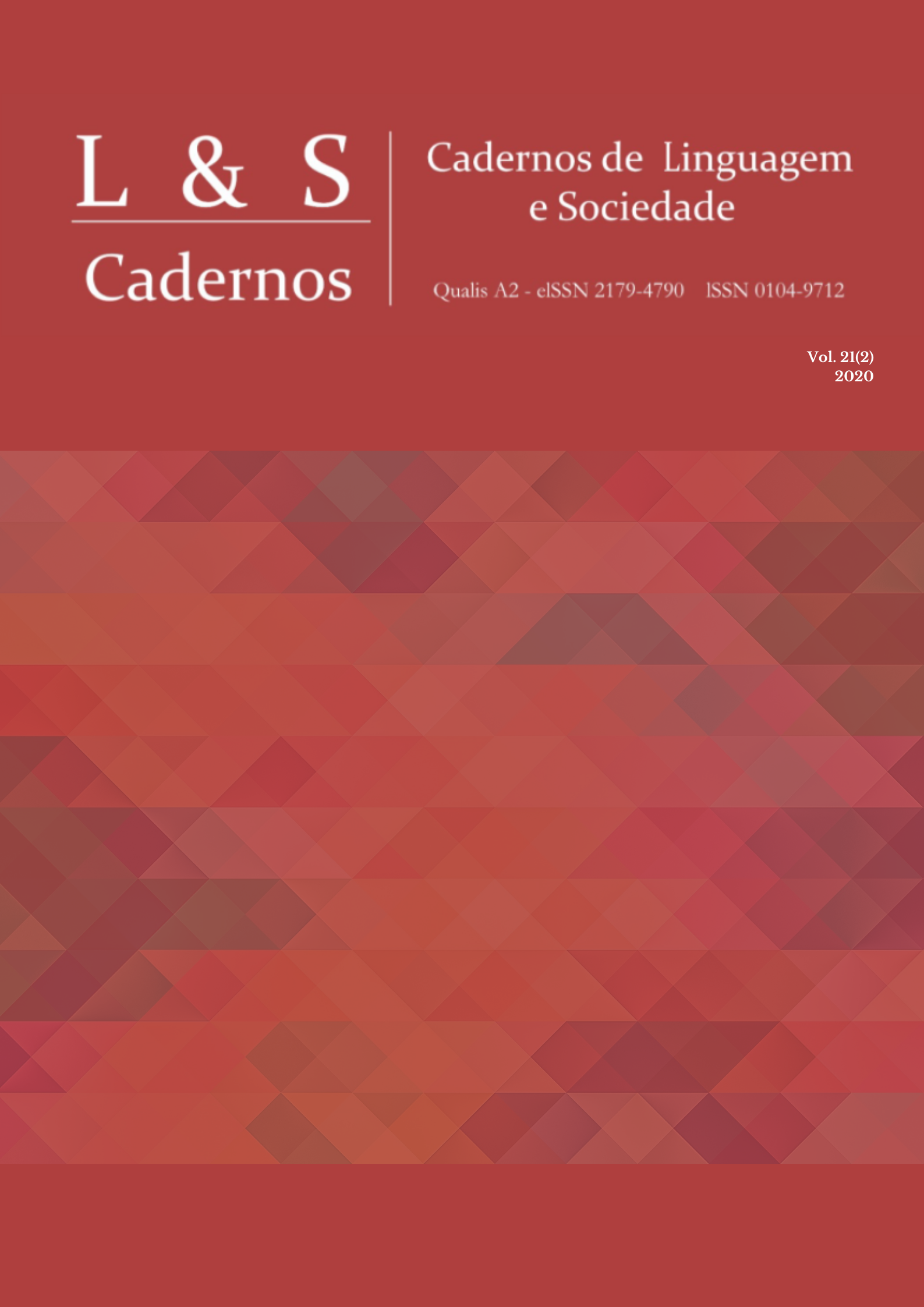Narrativização do sofrimento do outro na conversa cotidiana entre advogados
DOI:
https://doi.org/10.26512/les.v21i2.26405Palavras-chave:
Análise da Narrativa, Fala-em-interação, Identidade de grupo, Co-narrativaResumo
Dentre as práticas cotidianas desempenhadas pelos sujeitos nas mais variadas culturas, certamente o ato de narrar ocupa papel central, cujo lugar de destaque tem sido abraçado por diversos campos do saber para além dos estudos da linguagem. Seja para recaptular uma experiência passada, organizar a experiência ou quaisquer de suas funções, a narrativa representa um importante objeto que possibilita o investigador compreender a ordem social. A partir destas premissas, neste trabalho apresento algumas concepções em análise sociolinguística da narrativa, observando como narrativa e interação são engendradas em um almoço entre advogados que trabalham juntos em uma zona de conflito urbano.
Downloads
Referências
ARENDT, Hannah. Homens em tempos sombrios. São Paulo: Companhia das Letras, 1998.
BAMBERG, Michael. Construindo masculinidades na adolescência: posicionamentos e o processo de construção da identidade aos 15 anos. In: MOITA LOPES, L. P.; BASTOS, L. C. Identidades multi e interdisciplinares. Campinas: Mercado das letras, 2002. p. 149-185.
BASTOS, L. C. Contando estórias em contextos espontâneos e institucionais ”“ uma introdução ao estudo da narrativa. Calidoscópio, v. 3, n. 2, maio/ago. 2005.
BASTOS, L. C. Diante de sofrimento do outro: narrativas de profissionais de saúde em reuniões de trabalho. Calidoscópio. v. 6, n. 2, p. 76-85, maio/ago. 2008.
BAUMAN, R. Story, performance and event. Contextual studies of oral narrative. Cambridge: Cambridge University Press, 1986.
BLUM-KULKA, S. You gotta know how to tell a story: telling, tales and tellers in american and Israeli narrative events at dinner. Language in society. v. 22, p. 361-402, 1993.
BROCKMEIER, J.; HARRÉ, R. Narrativa: Problemas e Promessas de um Paradigma Alternativo. Psicologia: Reflexão e Crítica, v. 16, n. 3, p. 525-535, 2003.
BRUNER, Jerome. Acts of meaning. Cambridge, Harvard University Press, 1990.
CHANG, H. Autoethnography as Method. Walnut Creek, CA: Left Coast Press, 2008.
COATES, Jennifer. Masculinity, collaborative narration and the heterosexual couple. In: THORNBORROW, Joanna; COATES, Jennifer. (org.). The sociolinguistic of narrative. Philadelphia: John Benjamin B.V., 2005. p. 89-106.
DE FINA, Anna. Georgakopoulou, Alexandra. Introduction: Narrative analysis in the shift from texts to practices. Text&Talk, v. 28, n. 3, p. 275-281, 2008
DE FINA, Anna. Who tells which story and why? Micro and macro contexts in narrative. Text&Talk, v. 28, n. 3, p. 421-442, 2008.
DENZIN, N. K.; LINCOLN, Y. S. Introdução. In: DENZIN, N. K.; LINCOLN, Y. S. (org.). O planejamento da pesquisa qualitativa: teorias e abordagens. Porto Alegre: Artmed, 2006.
ELLIS, C., BOCHNER, A. P. Autoethnography, Personal Narrative, Reflexivity: Researcher as Subject. In: DENZIN, N. K.; LINCOLN, Y. S. Handbook of qualitive research. London: Sage Publication, 2000.
FABRÃCIO, B. F.; BASTOS, L. C. Identidade de grupo: a memória como garantia do nós face ao outro. In: PEREIRA, Maria das Graças Dias; BASTOS, Clarissa Rollin Pinheiro; PEREIRA, Tânia Conceição. (org.). Discursos sócio-culturais em interação: interfaces entre a narrativa,a conversação e a argumentação: navegando nos conceitos da escola, saúde, empresa, mídia, política, gênero e migração. Rio de Janeiro: Garamond, 2009. p. 39-66.
GARCEZ, Pedro M. Deixa eu te contar uma coisa: o trabalho sociológico do narrar na conversa cotidiana. In: RIBEIRO, Branca Telles; LIMA, Cristina Costa; DANTAS, Maria Tereza Lopes. (org.). Narrativa, identidade e clínica. Rio de Janeiro: Edições IPUB, 2001. pp. 189-213.
GOODWIN, C. Notes on story structure and the organization of participation. In: ATKINSON, Max; HERITAGE, John. Structures of social action. Cambridge, Cambridge University Press, 1984. p. 225-246.
GUMPERZ, John. Convenções de Contextualização. In: RIBEIRO, Branca Telles; GARCEZ, Pedro M. Sociolinguística Interacional. São Paulo: Loyola, [1982] 2002. p. 149-182.
JEFFERSON, Gail. Sequential aspects of story telling in conversation. In: SHCENKEIN, J. N. (ed.). Studies in the organization of conversational interaction, New York, Academic Press, 1978.
LABOV, W. Some further steps in narrative analysis. The Journal of Narrative and Life History, v. 7, n. 1-4, 1997. Disponível em: http://www. ling. upenn. edu/~wlabov/sfs. htm
LABOV, W. The transformation of experience in narrative syntax. In: LABOV, W. (org.). Language in the inner city. Philadelphia, University of Philadelphia Press, 1972, p. 354-396.
LABOV, W.; WALETZKY, J. Narrative Analysis: oral versions of personal experience. In: HELM, J. (org.). Essays on the verbal and visual arts. Seattle, University of Washington Press, 1967. p. 12-44.
LINDE, Charlotte. Life stories. The creation of coherence. New York, Oxford University Press, 1993.
MISHLER, E. Research interviewing context and narrative. Cambridge: Harvard Univeristy Press, 1986.
MOITA LOPES, L. P. Práticas discursivas como espaço de construção das identidades sociais: uma abordagem sociocioconstrucionista. In: RIBEIRO, Branca Telles; LIMA, Cristina Costa; DANTAS, Maria Tereza Lopes. (org.). Narrativa, identidade e clínica. Rio de Janeiro: Edições IPUB, 2001. p. 55-71.
NOGUEIRA, Mayara de Oliveira. Narrativas, prática profissional e ética social: negociação e coconstrução de identidades. 2018. Tese (Doutorado em Estudos da Linguagem) ”“ Programa de Pós-Graduação em Estudos da Lingusgaem da Pontifícia Universidade Católica do Rio de Janeiro, Rio de Janeiro, 2018.
NORRICK, N. R. Conversational storytelling. In: HERMAN, D. The Cambridge companion to narrative. Cambridge: Cambridge University Press, 2007. p. 127-141.
OCHS, E.; SMITH, R.; TAYLOR, C. Detective stories at dinnertime: problem-solving through co-narration. University of Southern California. Prepared for the American Ethnological Society Annual Meetings, Symposium on Narrative Resources for the Creation of Order and Disorder, St. Louis, Míssouri, March 25, 1988. p. 01-35.
PROPP, V. Morphology of the Folk Tale. Bloomington, Indiana University, 1958.
REED-DANAHAY, Deborah E. Auto/Ethnography: rewriting the self and the social. Oxford and New York: Berg, 1997.
RICOEUR, P. Narrative time. Critical Inquiry. 7 (1). 1980. pp. 169-190.
RIESSMAN, C. K. Narrative methods for the human sciences. California: Sage Publication, 2008.
SACKS, H. Ocupando-se em ser comum. Tradução Portela, Felipe; Pellegrino, Priscilla; Gomes, Vívian. Veredas: Revista de Estudos Linguísticos (On line). Atemática 1. Juiz de Fora, 2007 [1984]. Disponível em: http://www.revistaveredas.ufjf.br/volumes/veredas_atematica/traducao.pdf . Acesso em: 04 jul. 2015.
TANNEN, D. Conversational style. Norwood, NJ; Ablex, 1984.
TANNEN, Deborah; WALLAT, Cynthia. Enquadres interativos e esquemas de conhecimento em interação. In: RIBEIRO, Branca Telles; GARCEZ, Pedro M (org.). Sociolingüística interacional. São Paulo: Loyola, [1987] 2002. p. 183-214.
VELHO, Gilberto. Observando o familiar. In: NUNES, Edson de Oliveira (org.). A Aventura Sociológica. Rio de Janeiro: Zahar Editores, 1978. pp. 36-46.
VERSIANI, D. B. Autoetnografias: conceitos alternativos em construção. Rio de Janeiro: 7Letras, 2005.
WINKIN, Yves. A nova comunicação. Da teoria ao trabalho de campo. São Paulo: Papirus Editora, 1998.
Downloads
Publicado
Como Citar
Edição
Seção
Licença
Copyright (c) 2020 Cadernos de Linguagem e Sociedade do Programa de Pós-Graduação em Linguística da UnB é licenciado sob uma Licença Creative Commons Atribuição-Uso não-comercial-Vedada a criação de obras derivadas 3.0 Unported.

Este trabalho está licenciado sob uma licença Creative Commons Attribution 4.0 International License.
Autores/as que publicam nesta revista concordam com os seguintes termos:
Autores/as mantêm os direitos autorais e concedem à revista o direito de primeira publicação, sendo o trabalho simultaneamente licenciado sob a Creative Commons Attribution 4.0 International license que permite o compartilhamento do trabalho com reconhecimento da autoria do trabalho e publicação inicial nesta revista.



